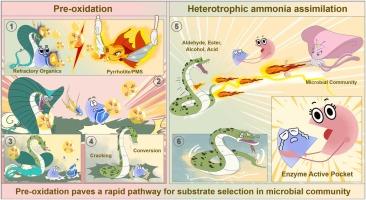对生产用水生物处理的新认识:预氧化为微生物群落选择底物铺平了快速通道
IF 12.2
1区 环境科学与生态学
Q1 ENGINEERING, ENVIRONMENTAL
引用次数: 0
摘要
由于碳氢化合物、表面活性剂、铵态氮和其他难处理有机物的共存,采出水(PW)的深度处理已成为一项艰巨的挑战。本研究在前期研究构建的预氧化耦合异养氨同化(PHAA)系统的基础上,改进了催化剂的选择并缩短了水力停留时间。稳定运行的 PHAA 系统去除了 96.2% 的总有机碳 (TOC)。研究模拟了有机负荷波动对系统的影响,并剖析了预氧化过程的机理及其对微生物群落的贡献。在反应器长期运行期间,预氧化过程大大提高了微生物群落处理负荷冲击的能力,并提高了压滤机的有机物降解效率。PHAA 工艺有效地去除了废水中 C24 以上的中长链烷烃,并提出了潜在的降解途径和方向。对碳氢化合物酶活性的测定表明,预氧化改变了底物的选择,使更多的醛类可作为微生物的辅助碳源。预氧化还丰富和保留了微生物的多样性,促进了 PHAA 过程中功能微生物的积累。本文章由计算机程序翻译,如有差异,请以英文原文为准。

New insight in the biotreatment of produced water: pre-oxidation paves a rapid pathway for substrate selection in microbial community
The deep treatment of produced water (PW) had emerged as a formidable challenge due to the coexistence of hydrocarbons, surfactants, ammonium nitrogen, and other refractory organics. On the basis of the pre-oxidation coupled heterotrophic ammonia assimilation (PHAA) system constructed in previous research, this work refined the catalyst selection and reduced the hydraulic retention time. The stable running PHAA system removed 96.2% of total organic carbon (TOC). The study simulated the effects of organic loading fluctuations on the system and dissected the mechanism of pre-oxidation process and its contribution to microbial community. Pre-oxidation significantly improved the ability of microbial community to handle loading shocks and improved organic degradation efficiency in PW during long-term reactor operation. The PHAA process effectively removed medium to long chain alkanes above C24 in PW and proposed potential degradation pathways and direction. The determination of hydrocarbon enzymes activity showed that pre-oxidation changed the substrate selection, making more aldehydes available as auxiliary carbon sources for microorganisms. Pre-oxidation also enriched and preserved microbial diversity, facilitating the accumulation of functional microorganisms in the PHAA process.
求助全文
通过发布文献求助,成功后即可免费获取论文全文。
去求助
来源期刊

Journal of Hazardous Materials
工程技术-工程:环境
CiteScore
25.40
自引率
5.90%
发文量
3059
审稿时长
58 days
期刊介绍:
The Journal of Hazardous Materials serves as a global platform for promoting cutting-edge research in the field of Environmental Science and Engineering. Our publication features a wide range of articles, including full-length research papers, review articles, and perspectives, with the aim of enhancing our understanding of the dangers and risks associated with various materials concerning public health and the environment. It is important to note that the term "environmental contaminants" refers specifically to substances that pose hazardous effects through contamination, while excluding those that do not have such impacts on the environment or human health. Moreover, we emphasize the distinction between wastes and hazardous materials in order to provide further clarity on the scope of the journal. We have a keen interest in exploring specific compounds and microbial agents that have adverse effects on the environment.
 求助内容:
求助内容: 应助结果提醒方式:
应助结果提醒方式:


